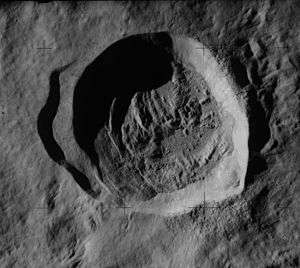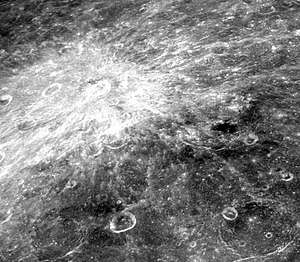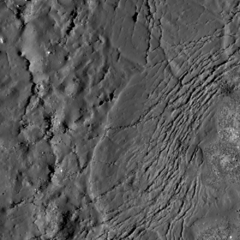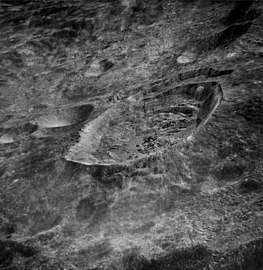Necho (crater)
Necho is a lunar impact crater on the far side of the Moon, and therefore cannot be seen directly from the Earth. It lies to the northeast of the larger crater Langemak, about a crater diameter to the south-southwest of Bečvář and further east is Love.
 Apollo 14 image | |
| Coordinates | 5.0°S 123.1°E |
|---|---|
| Diameter | 30 km |
| Depth | 2.1 km |
| Colongitude | 237° at sunrise |
| Eponym | Necho II |




Description
The most distinctive aspect of this crater is the prominent ray system that surrounds the outer rim. This higher-albedo skirt of ejecta extends in a nearly continuous fashion out for several crater diameters, but is more extensive to the north and northeast than elsewhere. Beyond this continuous skirt, occasional rays and wisps of light material extent outwards for many more crater diameters. Due to its prominent rays and generally very fresh appearance, Necho is mapped as part of the Copernican System.[1]
The mid-east and the middle part of the crater are mostly rough containing several hills.
The outer rim of Necho is somewhat uneven in form, particularly along the western side where it possesses two inner sides that overlap in almost spiral-like fashion. The rim has a slight outward bulge to the east, and is more uneven along that edge. The inner wall and floor has a high albedo, giving the crater a bright appearance. The inner side is generally wider on the western side, and the interior floor is offset to the eastern half.
Naming
The crater is named after Necho II, the king of the Egyptian 26th Dynasty.
The crater was informally called "the Bright One" by the Apollo 14 crew.[2] It was not formally named until 1976 by the IAU.[3]
Necho lies at the south edge of an unnamed, highly subdued, 200 km diameter crater which was originally discovered during the Apollo 16 mission and reported by Farouk El-Baz. The name Necho was proposed for the unnamed crater, but the name was eventually adopted for this smaller crater.[4]
Satellite craters
By convention these features are identified on lunar maps by placing the letter on the side of the crater midpoint that is closest to Necho.
| Necho | Latitude | Longitude | Diameter |
|---|---|---|---|
| M | 6.0° S | 123.1° E | 12 km |
| P | 6.8° S | 122.0° E | 75 km |
| R | 5.6° S | 122.0° E | 18 km |
| V | 4.3° S | 120.6° E | 16 km |
Notes
- The geologic history of the Moon, 1987, Wilhelms, Don E.; with sections by McCauley, John F.; Trask, Newell J. USGS Professional Paper: 1348. Plate 11: Copernican System (online)
- Figure 140 caption of Apollo Over the Moon: A View From Orbit, NASA SP-362, 1978
- Necho, Gazetteer of Planetary Nomenclature, International Astronomical Union (IAU) Working Group for Planetary System Nomenclature (WGPSN)
- Apollo 16 Preliminary Science Report (NASA SP-315), 1972, Chapter 29, Part H: Discovery of Two Lunar Features
References
- Andersson, L. E.; Whitaker, E. A. (1982). NASA Catalogue of Lunar Nomenclature. NASA RP-1097.CS1 maint: ref=harv (link)
- Blue, Jennifer (July 25, 2007). "Gazetteer of Planetary Nomenclature". USGS. Retrieved 2007-08-05.CS1 maint: ref=harv (link)
- Bussey, B.; Spudis, P. (2004). The Clementine Atlas of the Moon. New York: Cambridge University Press. ISBN 978-0-521-81528-4.CS1 maint: ref=harv (link)
- Cocks, Elijah E.; Cocks, Josiah C. (1995). Who's Who on the Moon: A Biographical Dictionary of Lunar Nomenclature. Tudor Publishers. ISBN 978-0-936389-27-1.CS1 maint: ref=harv (link)
- McDowell, Jonathan (July 15, 2007). "Lunar Nomenclature". Jonathan's Space Report. Retrieved 2007-10-24.CS1 maint: ref=harv (link)
- Menzel, D. H.; Minnaert, M.; Levin, B.; Dollfus, A.; Bell, B. (1971). "Report on Lunar Nomenclature by the Working Group of Commission 17 of the IAU". Space Science Reviews. 12 (2): 136–186. Bibcode:1971SSRv...12..136M. doi:10.1007/BF00171763.CS1 maint: ref=harv (link)
- Moore, Patrick (2001). On the Moon. Sterling Publishing Co. ISBN 978-0-304-35469-6.CS1 maint: ref=harv (link)
- Price, Fred W. (1988). The Moon Observer's Handbook. Cambridge University Press. ISBN 978-0-521-33500-3.CS1 maint: ref=harv (link)
- Rükl, Antonín (1990). Atlas of the Moon. Kalmbach Books. ISBN 978-0-913135-17-4.CS1 maint: ref=harv (link)
- Webb, Rev. T. W. (1962). Celestial Objects for Common Telescopes (6th revised ed.). Dover. ISBN 978-0-486-20917-3.CS1 maint: ref=harv (link)
- Whitaker, Ewen A. (1999). Mapping and Naming the Moon. Cambridge University Press. ISBN 978-0-521-62248-6.CS1 maint: ref=harv (link)
- Wlasuk, Peter T. (2000). Observing the Moon. Springer. ISBN 978-1-85233-193-1.CS1 maint: ref=harv (link)
External links
| Wikimedia Commons has media related to Necho (crater). |
- Necho at The Moon Wiki
- high-resolution photo of the interior from Apollo 14 (AS14-72-9975) at L&PI
- LTO-83B4 Necho — L&PI topographic map.
- 83B4S1(50) Necho Crater — L&PI Lunar Topophotomap Series, Scale: 1:50,000.
- Apollo 17 panoramic camera images with Necho near center: AS17-P-2461, AS17-P-2463, AS17-P-2466, AS17-P-2468
- LRO articles:
Related articles
- Wood, Chuck (April 27, 2007). "Necho's Peculiar Rays". Lunar Photo of the Day. Archived from the original on September 27, 2007. Retrieved 2007-04-27.
- Wood, Chuck (August 26, 2009). "Abusing Rocks". Lunar Photo of the Day.